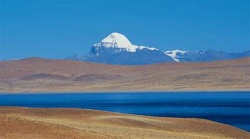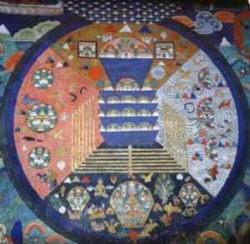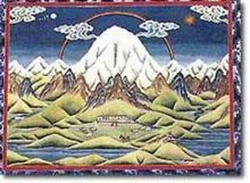Journey to Mt. Kailash
(This article was originally published in Turning Wheel: Journal of the Buddhist Peace Fellowship, Fall 1999) His Holiness the Dalai Lama has written, “…if people are so highly developed spiritually that they can practice their religions effectively by staying in one place, even in some unholy place, then a pilgrimage may not be important for them…. Many ordinary people, however, especially those who find religion difficult to practice in a devout way in their normal lives, set off on long journeys with the hope of communicating virtue and gaining merit.” Clearly, I fall into the latter category. For much of my life, I have struggled to maintain a consistent meditation practice at home, but will happily go into debt to travel to far-off lands in search of sacred sites. When I learned that my dear friend and teacher Roshi Joan Halifax was planning a journey to Mt. Kailash in western Tibet, I knew I had to join the trip.
For both Hindus and Tibetan Buddhists, Mt. Kailash is the center of the universe, the axis around which the world revolves. In Hindu cosmology it is the abode of Shiva, the god of destruction. For Tibetan Buddhists, it is the home of Demchog, the wrathful emanation of the Buddha. Both Buddhists and Hindus alike consider the pilgrimage to Mt. Kailash and the circumambulation around it (called a kora) to be the pinnacle of their spiritual life. Tradition has it that performing one kora will erase the bad karma of one lifetime, while 108 koras lead to full enlightenment. My own intentions were less lofty. Over the past five years, my practice with Joan had been in the mindfulness tradition of Thich Nhat Hanh and, more recently, as a member of Roshi Bernie Tetsugen Glassman’s Zen Peacemaker Order (ZPO). Tibetan Buddhism was fascinating to me, but I didn’t understand much about the rituals and symbolism. I simply wanted to make the journey to experience whatever the mountain had to teach me, and to try to live out the three tenets of the ZPO: Not Knowing, Bearing Witness, and Healing Ourselves and the World. It seemed especially important to bear witness to the courageous struggle of Tibetans to maintain their culture and religious traditions in their own land. In May of 1999, on a warm, smoggy day in Southern California, a group of fellow pilgrims from all over the United States gathered at Los Angeles International Airport to begin the journey. When we arrived in Kathmandu two days later, we were joined by others from Denmark, Switzerland, and India. In all, there were 20 of us, ranging in age from 17 to 67.
We would not arrive at Mt. Kailash until nearly three weeks later. Located in a remote corner of western Tibet, there is no fast, direct way to get to the mountain, no major airport for hundreds of miles. The pilgrim has to earn his or her way there with every step. In the old days, pilgrims walked for literally months to reach Kailash. Now, the trip is slightly easier, but still entails either a multiple-day drive from Lhasa in Landcruisers, or walking a number of days overland from Nepal, as we did. Lama Govinda wrote, “Nobody can approach the Throne of the Gods, or penetrate the Mandala of Shiva or Demchog, or whatever name he likes to give to the mystery of ultimate reality, without risking his life—and perhaps even the sanity of his mind.” The mountain exudes supreme bliss, but it is not easily gained. The wrathful energy of Kailash acts like a sword to cut through any illusions—physical, mental, or emotional—that get in the way of directly facing reality. I hoped to use this quality of the mountain to explore my bodhisattva nature and the obstacles that stood in the way of it shining forth. A large number of our group had never traveled to Asia before, and our first two days in Kathmandu bowled us over. Garbage, urine, and shit mixed together in the streets, diseased children begged for money or food, and diesel fumes choked the air. Suffering and poverty were clearly in view; nothing was hidden. How could we possibly make a difference in the face of such overwhelming despair? We flew from Kathmandu to Nepalganj, a smaller city in the southern part of Nepal, and then on to the Humla district in the northwest, where our trek would begin. Over the next seven days we trekked 35 miles through the high mountains, following the Karnali River, to the Tibetan border. We began at 9,000 feet and gradually worked our way up to nearly 15,000 feet. The trail was extremely mountainous. When Tenzin, our Tibetan guide, gave us a rundown of each day’s terrain, he would sometimes tell us that the trail was terzo, the Nepali word for smooth. Then he slyly smiled and made a rolling motion with his hands. Terzo meant that the ups and downs were only slightly less steep than mountain passes that would terrify a goat.
Day after day, we walked through terraced fields of barley, meadows of wild cannabis and nettles, and pine forests laced with waterfalls. The morning of the third day, I woke up feeling nauseous. Soon I began vomiting, but there was really no choice except to walk toward the next campsite. I lagged behind everyone else, accompanied by Tenzin and two sherpas who were saintly enough to stay with me the entire day. They carried my pack and stopped with me when I threw up every half hour or so. Ted, a fellow pilgrim and also a doctor, gave me some medication which eventually stopped the nausea. Until then, I just put one foot in front of the other and sweated my way along every inch of the trail. Demchog’s sword was cutting through my illusions of being invulnerable and not needing any help, assisting me in literally purging myself before approaching Kailash. On our final day before reaching Tibet, we had to cross Nara La, a mountain pass that we affectionately came to call Gnarly La. At altitudes near 15,000 feet, everyone’s breathing was labored and our pace became very slow. I understood why Tibetans use mantras so profusely; the only way to successfully walk in such conditions is to synchronize breathing with walking. My own mantra, with every step, became, “Just this, just this.” We finally reached the top of the pass, and were rewarded by the sight of a cairn of stones and prayer flags flying against the background of a sapphire blue sky. Following the Tibetan tradition, we each added a rock to the cairn and cried out, “So so so!” asking the gods to bless our journey and that of the pilgrims who would come after us. Having made it to the summit of the pass, I thought the way down would be easy. Another illusion waiting to be skewered! Going down the trail from the top of Nara La to the border turned out to be one of the most difficult and terrifying episodes of my life. After the pass, we skidded down a steep slope for about an hour and then traversed the side of an immense canyon. The slope below us angled down sharply more than 2,000 feet to the bottom. Several sections of this trail were no more than five inches wide, and those inches were not solid ground but rather loose rock and scree. While the sherpas virtually danced across these sections, we inched our way along and prayed we wouldn’t slip. Every so often, a herd of yaks would come from the opposite direction, and we stepped off the trail and clung to the canyon wall to let them pass. Meanwhile, Joan, on horseback because of a broken toe earlier on the trek, was four feet higher off the ground than the rest of us. Her horse’s every step sent showers of rocks cascading down the mountainside into the abyss. After this traverse was finished, we descended an extremely steep serpentine grade, slipping and sliding nearly 2,000 feet back down to the river before ending up in the town of Hilsa, on the border of China/Tibet. We had barely caught our breath when we realized that we would have to return over the same trail in a couple of weeks. The downhill we had just descended would be even more forbidding on the way back up, and the motivation of getting to Kailash would be gone. But there was no other way to get home. We conjured up ideas about how to fake an illness that would necessitate a helicopter evacuation, thus avoiding the walk back over Nara La. Ted, who had practiced in Thich Nhat Hanh’s tradition, lifted one of Thây’s favorite phrases to remind us that “fun is made up of non-fun elements.” We were allowed to cross the border into China/Tibet with no problems, a blessing considering that the U.S. bombing of the Chinese embassy in Yugoslavia had taken place a couple of weeks before we arrived. We continued over the Tibetan high plateau, a harsh barren country resembling a moonscape, to Lake Manosarovar. Surely one of the most beautiful places on earth, the lake stretches across the vast, empty, brown desert plain as far as the eye can see. We spent five days on the north shore in solitude and silence, preparing ourselves for the kora that lay ahead of us. Most mornings, the water was absolutely calm and still, like the surface of a mirror. By the afternoon, the wind began to rise and waves rolled onto the shore. This land was elemental: extreme sun, unrelenting wind, no trees for shade, and the earth littered with the bones of sheep and yak who had expired here. From a hillside high above the lake, I looked out and marveled at the gradations of color that changed with the water’s depth—turquoise to light green to dark emerald to deep lapis blue—and considered the unknowable depths and mysteries of our own souls.
We finally reached Darchen, the beginning point of the kora, on May 29. The next day, Sagadawa (Buddha’s birth, enlightenment, and paranirvana), we emerged from our tents into several inches of fresh snow. From that point on, snow fell on each of the five days we took to circle the 32-mile perimeter of Kailash. By the time we reached the north side of the mountain, the nighttime temperature dropped to about 20 degrees below zero. The daytime temperature was warmer, but still well below freeezing—our water bottles froze as we walked. I turned to my tentmate and good friend Andrea and wondered aloud if we would ever be warm again. We didn’t sit in zazen very much on the trip; the walk and the trail itself became our meditation. The Kan Ro Man, a Soto Zen service adapted by Tetsugen Glassman to include Tibetan and Jewish elements, was the keystone of our journey. In the ceremony, we chant, “By this practice I sincerely wish to extend all my love to my own being, friends, enemies, family, and community and to all creations for so much done on my behalf… May those suffering on the three paths come to atonement and be cleansed of all their ills. May they be liberated from samsara and arrive in the Pure Land Together.” We are asked to put our whole bodies on the line to feed the hungry ghosts, to heal our suffering and the world. We performed the service twice—once in Nepal at the convergence of two powerful rivers, and then at a sky burial ground at the foot of Mt. Kailash, amidst butcher knives, pools of blood, and fragments of bone and flesh. For Tibetans, a sky burial is a very honored ritual. The body is dismembered and then left for vultures and the elements. As we circled the mountain, Joan taught us about the mandala of Mount Kailash. Each direction of the mountain, including the center, is home to one of the Five Buddha Families. Perhaps most importantly, we were reminded that Zen is about bringing every element into the mandala of our practice, excluding nothing. Walking around the mountain, we entered this living mandala and reflected on parts of ourselves and the world around us that we had rejected. On the third day of the kora, we ascended through a snowstorm to the Dolma La pass, the highest point of the route at 18,600 feet. Several hundred feet before the top of the pass, we stopped at another burial ground. Along with other pilgrims, we laid down and visualized our own deaths, meditating on the truth of impermanence. The symbolic meaning of the kora is that we die to our old way of being, and as we cross over the Dolma La, we are reborn. When we reached the top of the pass, faint from altitude, we helped each other to climb up on the Tara rock to leave prayer flags and wishes for peace in a world torn apart by war. Joan had brought the ashes of her father who had died the year before, and Pam brought her brother’s ashes. As the snow and wind pelted us, we chanted to Kanzeon and conducted a ceremony for Werner, who was entering the Zen Peacemaker Order. Overcome with emotions, tears of gratitude and exhaustion washed over me. We tumbled down the trail to our next campsite on the east side of Kailash, weary but renewed. After the kora was finished, we slowly made our way back towards Kathmandu the same route we had come, back to the Tibetan border, over the dreaded Nara La, and through the mountainous Humla area. Strangely, Nara La no longer seemed so treacherous. I marveled at my lack of fear and ability to walk the trail with strength and confidence. A few days before the end of our trek, the monsoons set in and rain fell day and night. The last day’s walk was very easy, no more than two hours, descending through lush pine forests, rhododendron groves, and jasmine. Although I had been longing for a hot bath and a dry place to sleep, the sudden realization that I was about to leave the realm of mountains, rivers, trees, and clouds saddened me greatly. I was leaving a world where time is measured by how long it takes for the burning sensation of the stinging nettles to fade away and how many days to walk from one village to another. I wanted to carry some sense of that wildness with me—the raw beauty of the mountain that mirrors our unadorned selves, the fearlessness and complete trust that permeates Nature. When we finally returned to Kathmandu, I noticed that I did not turn away from the eyes of a hungry child, or avoid breathing the polluted air, as I had done before. Aversion had been replaced by openness and curiosity, by a much greater receptivity to the full spectrum of suffering and joy present in life. And with this openness came a yearning to alleviate the sufferings and celebrate the joys. What a great gift Kailash had bestowed upon me! I am sure that His Holiness is right when he says that people can practice their religion effectively by staying home. But for me, the Dharma came vividly alive through this journey to a sacred mountain and immersion in another culture that forced me to let go of all that I knew. The words of Milarepa, the great Tibetan yogi and poet, echoed through my mind: “Just to leave home is half the Dharma.” _____________________ Maia Duerr is a writer, editor, anthropologist, and founder of Five Directions Consulting. She practices Zen Buddhism and has worked with the Buddhist Peace Fellowship, Upaya Zen Center, Parallax Press, and the Center for Contemplative Mind in Society. She writes The Jizo Chronicles, a blog on Socially Engaged Buddhism, found at http://jizochronicles.wordpress.com/.




